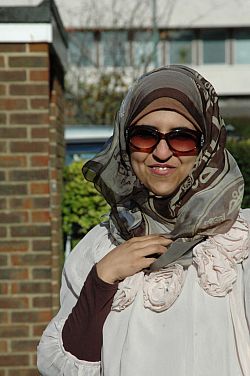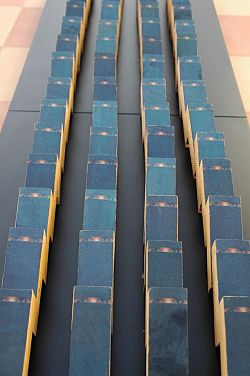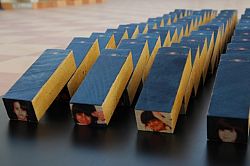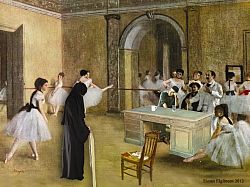Artist student’s work selected for 55th Venice Biennale
Sussex research student Eiman Elgibreen has been selected to exhibit her work at the 55th Venice Biennale – one of the world’s most influential art exhibitions.
 Artist and art historian Eiman Elgibreen at the University of Sussex.
Artist and art historian Eiman Elgibreen at the University of Sussex.
 'Does a face make a difference?' by Eiman Elgibreen, exhibited at the Venice Biennale 2013.
'Does a face make a difference?' by Eiman Elgibreen, exhibited at the Venice Biennale 2013.
 'Does a face make a difference?' by Eiman Elgibreen, exhibited at the Venice Biennale 2013
'Does a face make a difference?' by Eiman Elgibreen, exhibited at the Venice Biennale 2013
 'Do not judge me, just look at my work!' by Eiman Elgibreen, exhibited at the Venice Biennale 2013.
'Do not judge me, just look at my work!' by Eiman Elgibreen, exhibited at the Venice Biennale 2013.
Eiman, who is studying for a doctorate in art history, is already known as an award-winning artist, journalist and academic at home in Saudi Arabia, where she is a lecturer at the Princess Norah University in Riyadh.
Eiman’s work – incorporating photography, painting and sculpture – challenges current stereotypical views of women who adhere to the conservative dress codes of Saudi culture.
In her latest collection, ‘Out of context’, veiled women are presented in scenarios that challenge prejudice and invite the viewer to appreciate individual talent and achievement over appearance.
In one double portrait or diptych, ‘Banksy and I’, Eiman’s own veiled self mirrors that of the silhouetted and “faceless” yet celebrated graffiti artist known only as Banksy.
Two other works by Eiman – a sculpture entitled ‘Does a face make a difference?’ and a series of six photomontage paintings entitled ‘Do not judge me, just look at my work!’ – were chosen by the curators of a group exhibition entitled Rhizoma (Generation in Waiting), commissioned by the Edge of Arabia foundation, which will show at the Venice Biennale (1 June-24 November).
Eiman says: “Of course I feel proud to have been selected. The message of my current collection might seem shocking to some, as I portray veiled women in different and surprising contexts. These women have made their own choices and refuse to compromise, regardless of the context. I believe that I have an obligation to tell the other side of the story of what it means to be a Saudi woman.”
While lecturing in Saudi Arabia, Eiman won a scholarship and decided to study for a doctorate at Sussex, where she is now researching the pioneering Saudi female artist Safeya Binzagr.
Eiman says: “Safeya Binzagr was able to make a huge difference not only in the Saudi art scene, but also on a social, cultural, and historical level. She is now the only Saudi artist who has her own museum, and she did all that without trying even once to breach the norms of her society.
“I strongly believe that conservative women are as influential as radicals or liberals, but to appreciate that we need to change the ways we assess their work.”
Once Eiman has completed her PhD studies she plans to return to lecturing in Saudi Arabia and to set up her own art foundation, devoted to promoting Saudi art and culture. She will be seeking international collaborations and getting recognition for emerging conservative female artists.
Eiman says: “Saudi Arabia is an extremely large country, so we still need more artists to represent the diversity of its cultural groups. However, the young generation is certainly shaping current events in the country and decision makers find themselves more obliged to hear what they have to say.
“The Rhizoma exhibition presents very conflicting ideas, especially in the work of female artists, which is what I am most excited about. I think it will give the audience an opportunity to understand that women in my country are opinionated and capable of discussing their own issues.”
Dr Meaghan Clarke, Senior Lecturer in Art History at Sussex and Eiman’s doctoral supervisor, says: “Eiman's work is indicative of the inclusive and innovative nature of research in the Department of Art History.”
